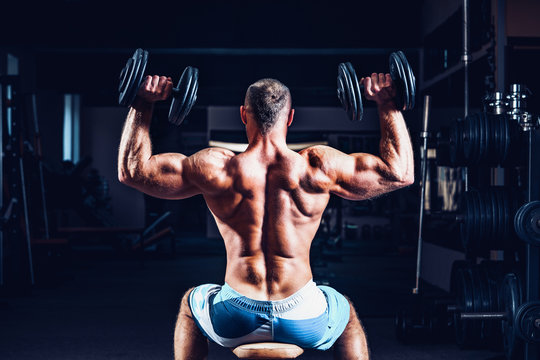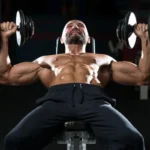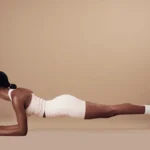Welcome to fit24vibes, your ultimate destination for all things fitness! If you’ve come to build a strong, sculpted, and muscular shoulder, you’ve come to the right place. We might obsess about building bigger biceps and bulging chests. Now it is your turn to build well-rounded shoulders, not to mention it has an aesthetic benefit when you wear out tank tops or sandos. In this article, we’ve put the ultimate guide for the best shoulder workout at the gym, designed to help you achieve maximum gains and desire sculpted shoulders. We’ll cover a range of exercises, from the classic shoulder press to effective dumbbell movements, instructions and muscle groups it targets ensuring you have a comprehensive plan for your shoulder day.
WHY SHOULD YOU DO SHOULDER WORKOUTS ?
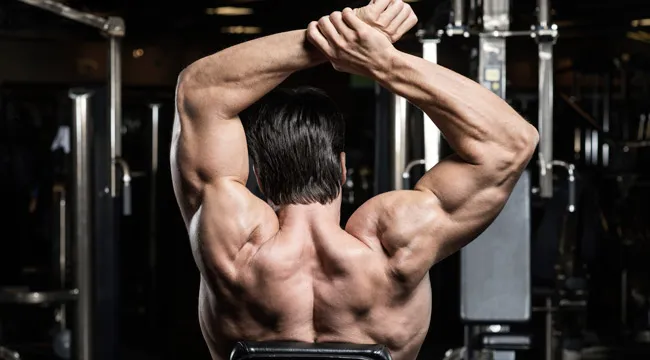
As it is not the strongest muscle group in the body but whether you’re a seasoned lifter or a beginner, targeting the shoulder muscles will massively benefit your lifting, and improve body posture, and overall upper body strength. The shoulder muscles play a key role in aiding stability in pushing and pulling exercises. Before diving into the best shoulder workout at the gym, we need to understand the shoulder muscles which are made of 4 major muscles:
- Rotator Cuff ( groups of muscles and tendons that surround the shoulder joints)
- Deltoids (it is the largest muscles of the shoulder located on the outside of the shoulder)
- Anterior Deltoid / Front Delts (located to the front of the shoulder)
- Lateral Deltoid / Medial Delts (located behind the anterior deltoid)
- Posterior Deltoid / Rear Delts (located at the back of the shoulder)
- Rhomboids (located at the top of the upper back down between the shoulder blades)
- Trapezius (it is triangle shaped muscle located on the upper back)
The Best Shoulder Workout at the Gym
At fit24vibes we will explore the best shoulder workout at the gym which is divided into several key exercises, targeting different parts of your shoulder muscles, providing a comprehensive and effective approach. This best shoulder workout at the gym will ensure you hit the major deltoid muscles from various angles for optimal growth.
Here are the 6 best shoulder workouts at the gym that you can try and add in your workout routine:
1. Overhead Press
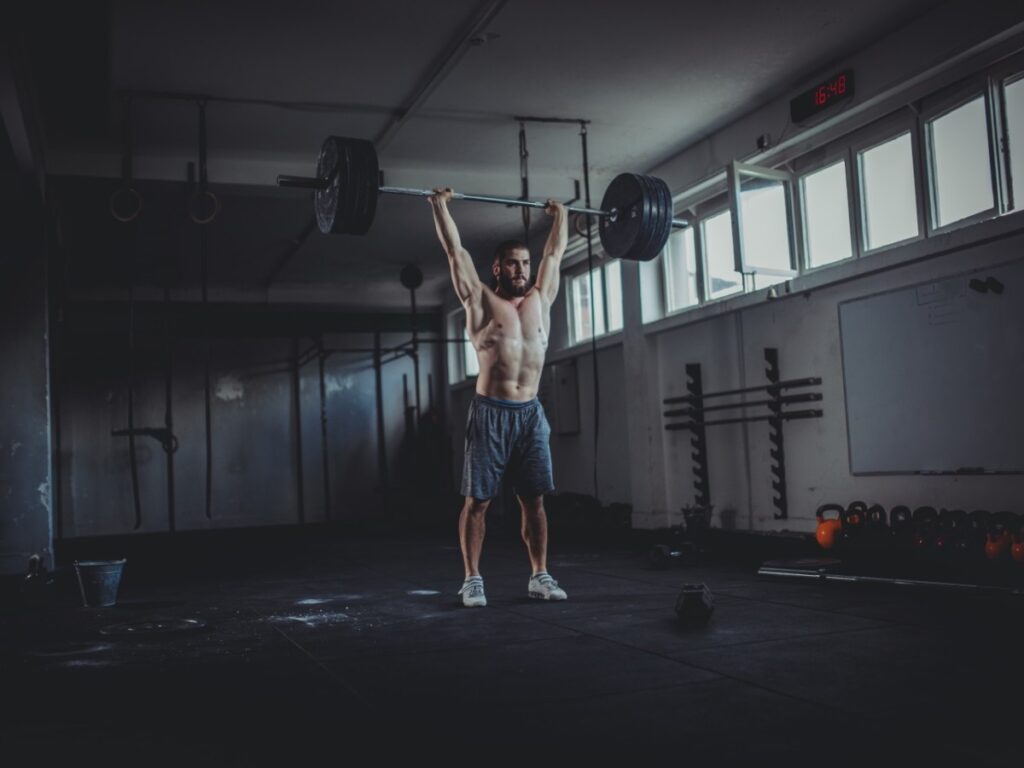
The overhead press is a compound shoulder exercise that targets the whole upper body which involves the shoulder muscles, the triceps, the traps, and the lats as well as core and glutes. It is also know as shoulder press, strict, or military press which is almost used in weight-training exercises.
It is one of the best shoulder workouts you can add to your workout plan for building strength and size of shoulder muscles. It can be performed by seating or standing using either a pair of dumbbells or barbells. It involves pushing the weight directly upwards from the shoulders until the arms are extended fully.
Instruction:
- You can begin by sitting on a bench or standing, grab a barbell, or pairs of dumbbells slightly wider than the shoulder-width under the chin.
- Keep your knees a little soft for stability, but don’t use take aid to lift.
- Throughout the movement keep your core engaged, glutes tight, and a neutral spine.
- Take inhale, press the bar or dumbbells straight up overhead by extending your arms but make sure not to lock the elbows as it can cause injury due to heavy load.
- Exhale, slowly lower the bar or dumbbells to a starting point.
- Ensures that the bar or dumbbells stay vertical throughout the repetition and don’t lean back as you press.
Tips:
- To correct the proper form, always begin with the bar and lightweight. Practice the proper form with a higher-range rep if you are a beginner.
- Keep your eyes through the bar to avoid unwanted contact with your head and chin throughout the movement.
- Use of a squat rack to adjust the height, adding weight, and re-racking the bar is much easier than putting back it on the floor.
2. Lateral Raises
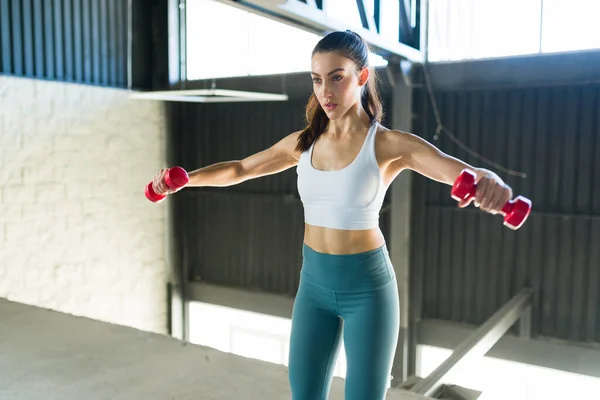
The lateral raise is one of the few isolation shoulder workouts that target the Lateral Deltoids or Medial Delts, which are the primary shoulder muscles for creating the iconic v-shaped top half. It also activates the upper back muscles including traps, rhomboids, levator scapulae and serratus anterior.
It is an isolation movement that is performed by raising the arms laterally away from the midline which targets a single muscle group. allowing it to be worked close to failure to maximize gains. It can be performed by dumbbells, cables, and by standing or seating.
Instruction:
- Stand or sit on a bench in an upright position, and have a neutral grip on a pair of dumbbells.
- Keep your shoulders back, core engaged, and chest up before the repetition.
- Inhale and raise the dumbbell upward, away from the midline of the body equal to shoulder height making a T shape, and make sure to bend the elbow throughout the movement.
- Pause, exhale, and lower the dumbbells to the starting point.
Tips:
- Performing the lateral raises while standing, make sure not to swing your body.
- Don’t go for rush as you’ll not able to focus on your muscle growth, while performing raise the dumbbells for 3secs and hold for 1sec and repeat this movement.
- Don’t lift the dumbbells too high from shoulder as it will take focus to the traps instead of shoulder.
3. Frontal Raises
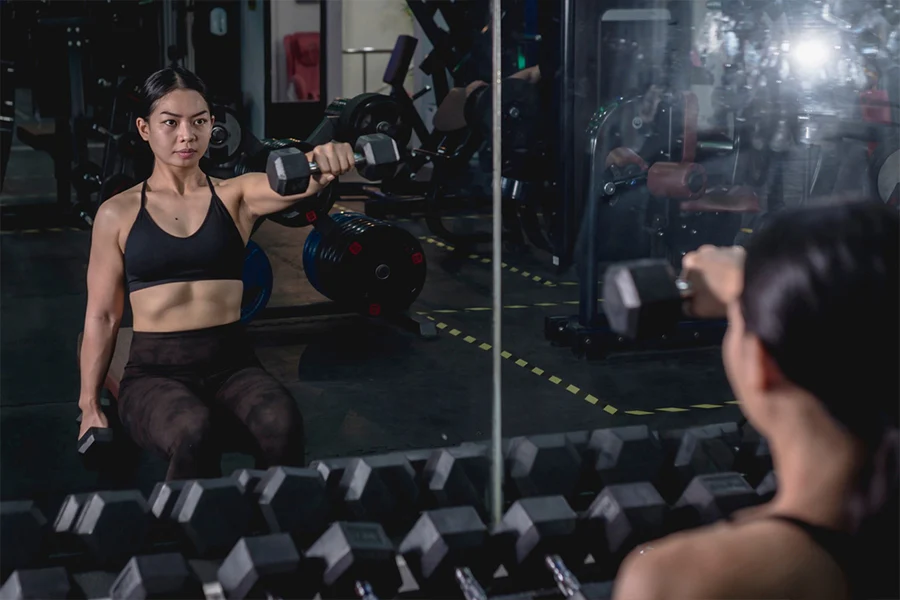
The frontal raises is also an isolation shoulder workout that is similar to lateral raises and with the name it targets the Anterior Deltoids or Front Delts, which are the secondary shoulder muscles. It also activates the upper back muscles including traps, triceps, and biceps in your arms, rhomboids, levator scapulae, serratus anterior, and the pectoral muscles of your chest so you can also add this to your chest workout.
It is an isolation movement that is performed by raising the arms front away from the midline of the body to shoulder level which targets a single muscle group. It has a variation of dumbbells, cables, barbells, and by standing or seating.
Instruction:
- Stand or sit on a bench in an upright position, and have a neutral grip on a pair of dumbbells or barbells.
- Keep your shoulders back, core engaged, and chest up before the repetition.
- Inhale and raise the dumbbell or barbell front upward, away from the body equal to shoulder height where the palm faces the floor, and make sure to have a soft bent elbow at the top of the movement.
- Pause, exhale, and lower the dumbbells to the starting point.
Tips:
- Performing the front raises while standing, make sure not to swing your body it will not give proper focus on anterior delts. So try not to go for heavy weight, use lightweight with max. rep range.
- Don’t go for a rush as you’ll not be able to focus on your muscle growth while performing raise the dumbbells for 3secs, hold for 1sec, and repeat this movement.
- When you lift the dumbbells or barbell to shoulder height, don’t lock your elbow as it will cause injury so have a soft bend elbow.
- Don’t lift the dumbbells too high from the shoulder as it will take focus to the traps instead of the shoulder.
4. Rear Delt Fly

The rear delt fly is a pulling or rowing shoulder exercise that targets the Posterior Deltoids or Rear Delts, which are back muscles in the shoulder. It is one of the most undertrained muscles in our body as the 1\3rd part of the shoulder muscles. It also targets the secondary muscles such as the trap, lats, and rhomboids.
If you’re a bodybuilder, powerlifter, or hybrid athlete the rear delt muscles are essential for effective shoulder movement, improved posture, and support of the muscles in the back. They are responsible for arm extension and external rotation. Rear delt is often performed by pairs of dumbbells but it can be variates through the Pec Dec Fly machine which is mostly used for chest workouts.
Instruction:
- Stand or sit on the edge of the bench in an upright position, hip backward like squat, and have a neutral grip on a pair of dumbbells and bend your knees slightly
- Bent your back forward facing the ground and spine elongate, core engaged through the movement.
- Hang your arm downward below the shoulder where palms face each other.
- Inhale and raise the dumbbell upward, away from the body equal to shoulder height, and make sure to have a soft bent elbow at the top of the movement.
- Engage your shoulder blades as you raise the weight to the sides.
- Pause, exhale, and lower the dumbbells to the starting point.
Tips:
- Performing the rear delt fly while standing, make sure not to swing your body it will not give proper focus on rear delts. So try not to go for heavy weight, use lightweight with max. rep range.
- Use your shoulder blades back and down to stabilize your body.
- If you have a rounded back throughout the movement, bend your knees slightly which prevents pain in the back.
- Lift the dumbbells perpendicular to shoulder height, don’t lock your elbow as it will cause injury so have a soft bend elbow.
- Don’t lift the dumbbells too high from the shoulder as it will take focus to the traps instead of shoulder muscles.
5. Face Pulls
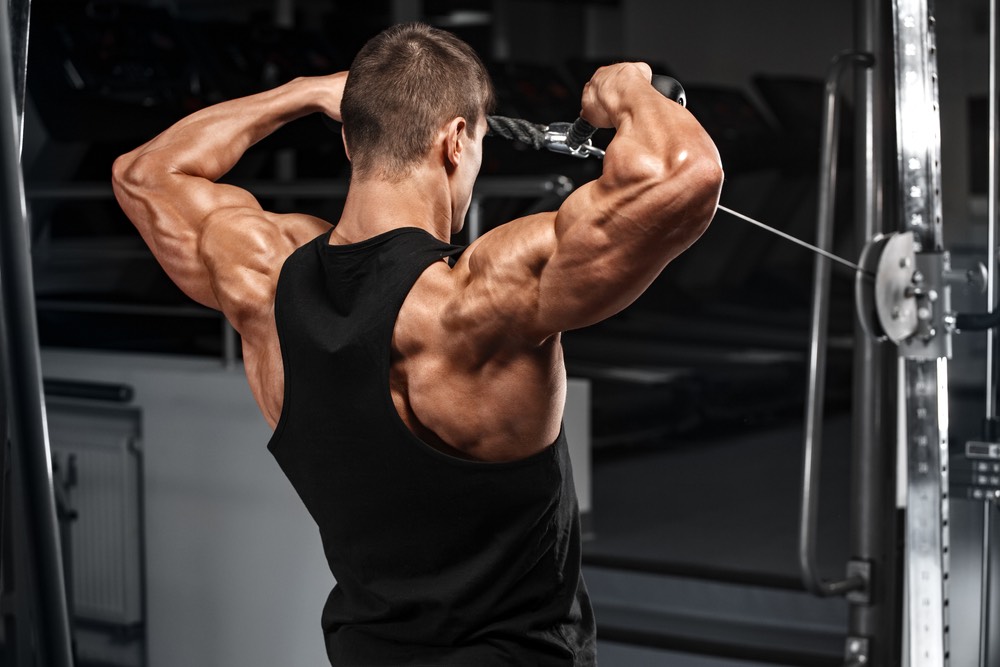
The face pulls is an isolation cable shoulder workout that targets the Posterior Deltoids or Rear Delts, which are back muscles in the shoulder. It involves a horizontal pull, moving weight out in front of the midline face. It required less weight to build strength and size within the target muscles. It also targets the secondary muscles such as trap and rhomboids.
To perform face pulls you have to set the cable height, setting the cable to above head level will more target the rear delts and rhomboids, while lowering the cable below head level will put more targets on rear delts and traps.
Instruction:
- Take a rope extension and attach it to the cable machine, adjust the cable above head level.
- Grab the two ends of the cable with your hand, with where thumb on the top and palm facing down.
- Stand a few steps back with your extended arms in front of you where feet should be shoulder-width apart.
- Slightly lean back engaging your core.
- Inhale and pull the two ends towards your forehead, bring the handles near your ears where elbows flair out the side level with your wrist and hands.
- Engage your rear delts when you pull the handle at the movement.
- Pause, exhale, and release the handle to the starting point.
Tips:
- Don’t go for heavy weight, use the weight with which you are comfortable to perform the workout effectively throughout the movement.
- To take advantage of this shoulder exercise you need to maintain a proper form i.e., stand up tall, elbows pointing out, and shoulder down and back.
- If you feel discomfort or experience pain in your lower back, take a staggered stance. You can kneel with the same instruction and can perform this exercise.
6. Upright Row

The upright row is a versatile shoulder exercise that targets the anterior deltoids or front delts, which are the front muscles in the shoulder. It is a simple movement but very effective to build strength for rows, deadlifts, and pull-ups It involves a vertical pull, moving weight upward to shoulder level. Start with lightweight, concentrating the muscle contraction into high rep range until you master the movement. It also targets the secondary muscles such as the trap so you can add this workout to your trap workout routine.
It is usually performed in a barbell or EZ bar, which you are going to fall award at first, but if you want to increase your shoulder’s size and strength of your shoulder it’s worth including in your shoulder workout. If you’re an Olympic Lifter, mastering this movement may help you to throw more weight above your head. The upright row can also be performed by using pairs of dumbbells, using one arm at a time.
Instruction:
- Stand up straight, feet shoulder-width apart. Load the barbell or EZ bar with a light or comfortable weight.
- Grab the bar (EZ bar) with an overhand grip shoulder-width apart, palm facing down, and hold the bar downward with extended arms.
- Take a breath in, engage your core, and squeeze the glutes. Driving the elbow in an upward direction, bend your arms to bring the bar to your chin.
- Bring the weight to your shoulder level, give pause engage the upper back muscles, then lower the weight to the starting point.
Tips:
- Lifting the weight higher than your shoulder level can cause injury or pain. Ensure you pause the bar to shoulder level
- If you’re lifting too much heavy weight, it will require your body momentum which can shift the focus from your shoulder or put more stress on it. So choose a weight that’ll allow you for slow and controlled movement.
- It’s important to keep your torso upright and core engaged through the movement.
HOW TO STRUCTURE YOUR SHOULDER WORKOUT PLAN?
So now you can have all the best shoulder workouts you have explored, but if you don’t know how to structure your effective shoulder workout plan, then you won’t get very far. Generally start with the compound exercises before moving on to the isolation exercises.
Set this hypertrophy rep range in your goal, that being said, start by performing a heavy-weight compound workout in a lower rep, along with a higher rep for light-weight as a finisher at the of end the session, which will help to optimize the muscle growth. Alongside this, you also must go for progressive overload, which essentially means that you see the progress by increasing the difficulty of your sessions each week, by usually increasing the load.
You make sure that you’re hitting all the major muscle groups of the shoulder using heavy presses, compound workouts, and isolation movements to develop an equal top half. Include good shoulder warm-ups and post-workout stretches along with shoulder workouts to build size. Perform the following shoulder workouts listed below, where you can change the sets or load on weekly basis:
- Overhead Press \ Shoulder Press: 3 sets of 10-12 reps
- Lateral Raises: 3 sets of 12-15 reps or failure reps
- Frontal Raises: 3 sets of 12-15 reps or failure reps
- Rear Delt Fly: 3 sets of 10-12 reps
- Face Pulls: 3 sets of 8-12 reps
- Upright Row: 3 sets of 10-12 reps
As per the medical point, the shoulder is a complicated joint so take 5-10 minutes to properly warm up the shoulder joints before the start of your shoulder workout which fundamentally ensures to prevent injuries and good range of motion. While you can do the shoulder warm-up exercises just using your body weight, but we recommend using a light, long resistance band to activate the shoulder muscles. Don’t be tempted to walk straight out of the gym after your shoulder workout, take a few minutes to perform some post-shoulder workout stretches which can be beneficial.
As mentioned, the shoulder is a complicated joint, even if you’re not doing the dedicated shoulder workout, you can include the shoulder exercises on the chest or back workout day, rather than doing the shoulder workout the whole day. But always take adequate time for recovery between sessions to avoid overtraining or injury.
Share this post: on Twitter on Facebook
